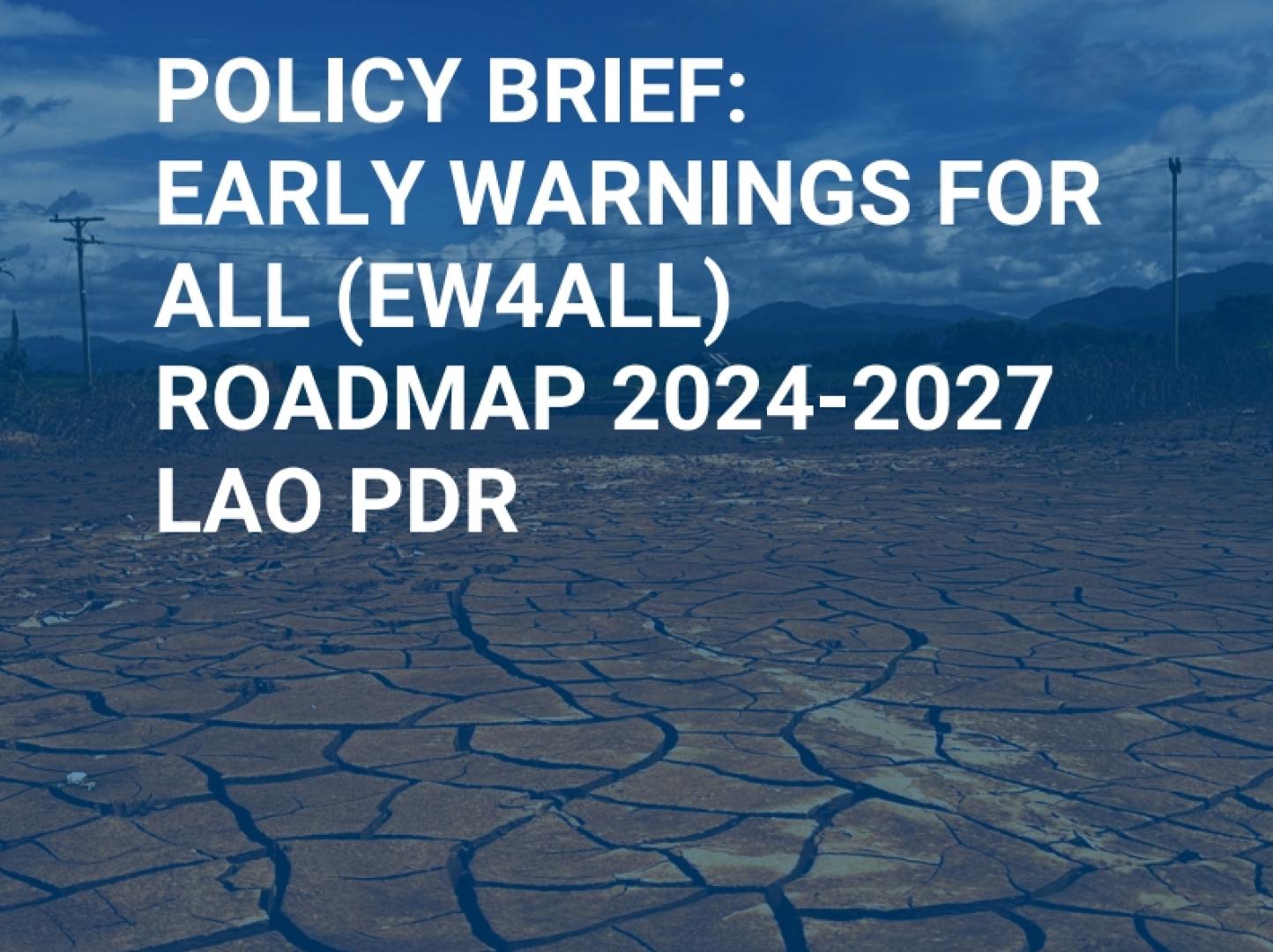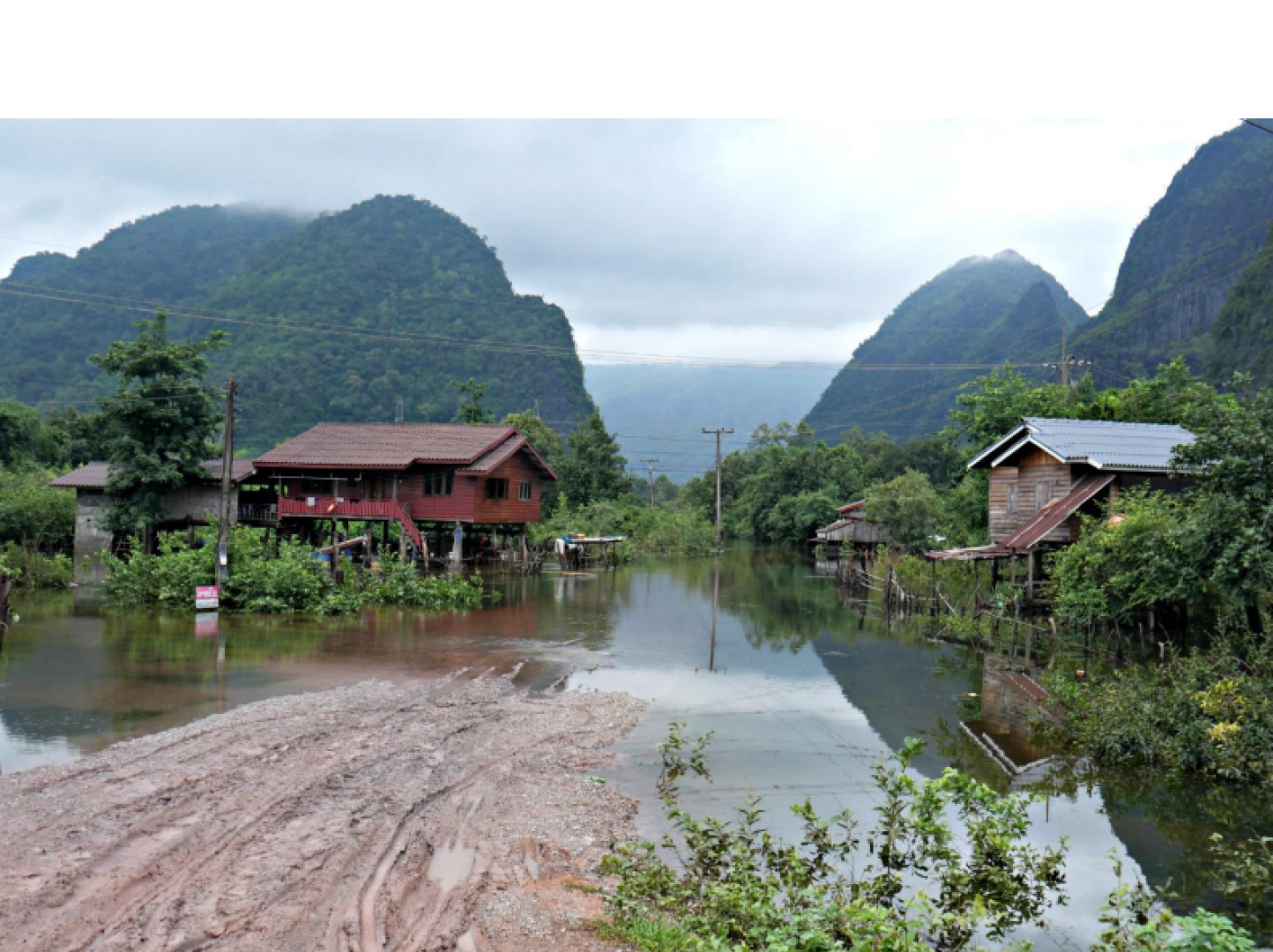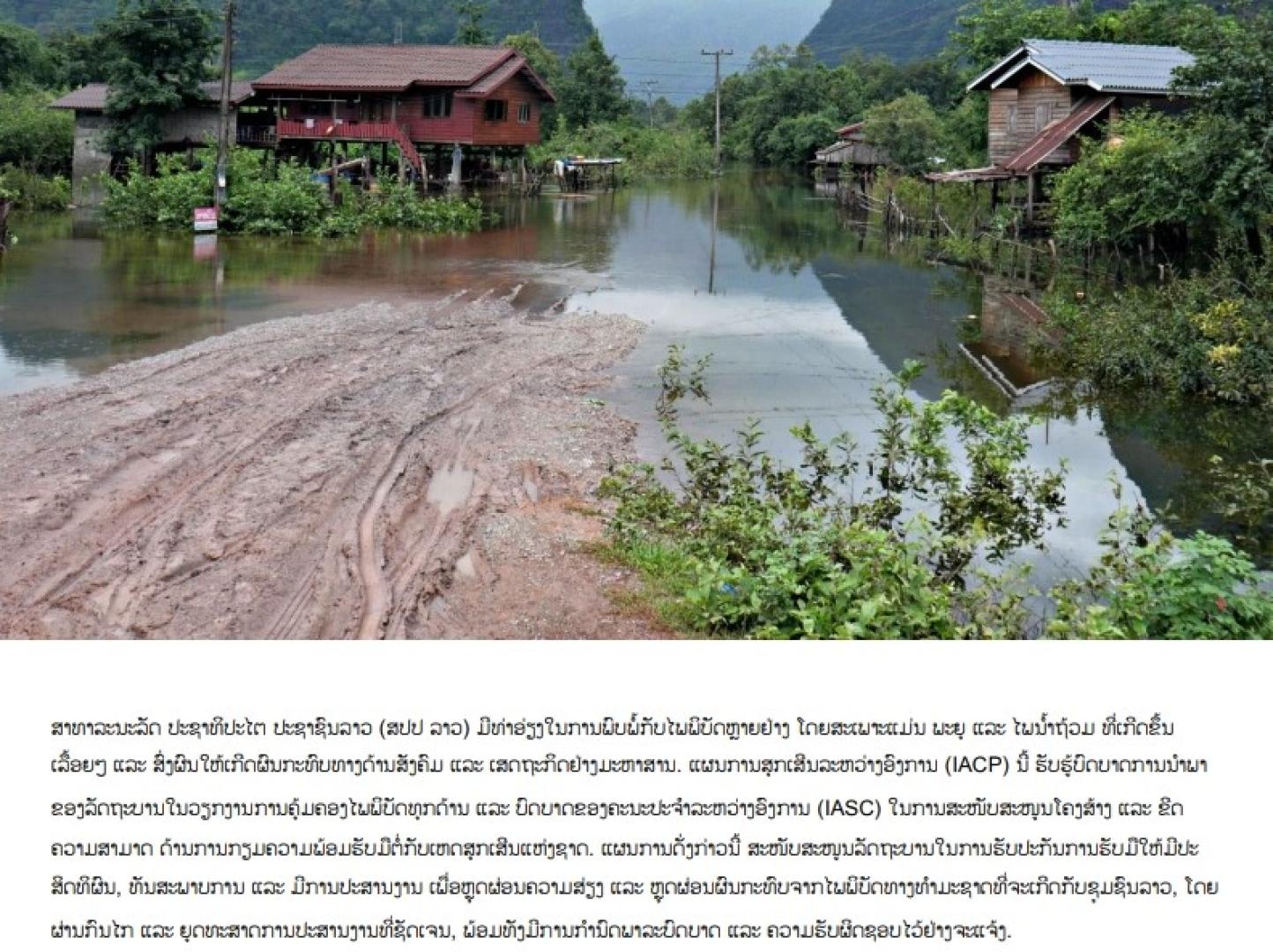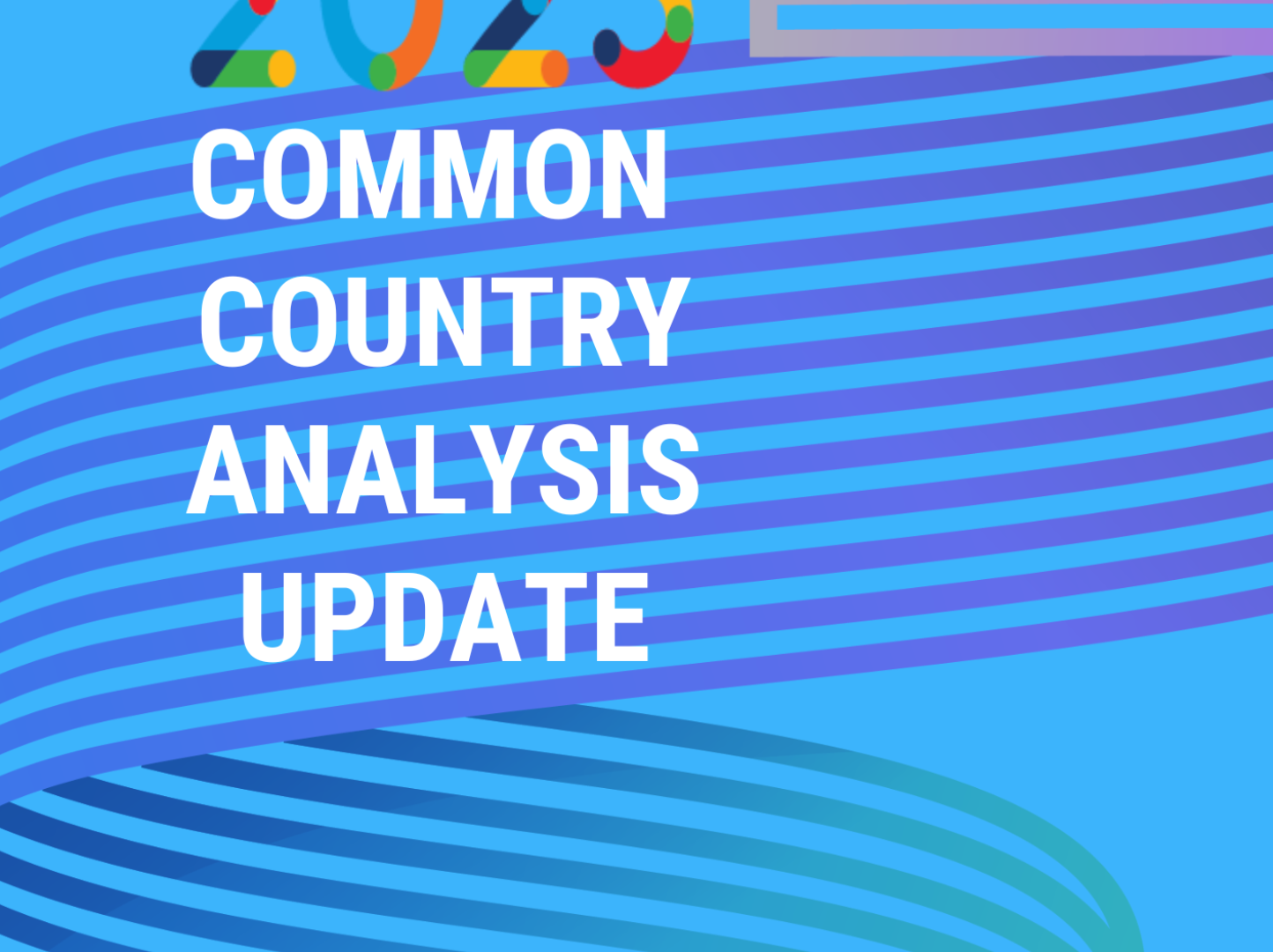Latest
Story
17 December 2025
Brewing Change: From Opium Poppies to Premium Coffee in the Mountains of Lao PDR
Learn more
Press Release
12 December 2025
Lao People’s Democratic Republic launches its first social security mobile application
Learn more
Press Release
12 December 2025
Second National Symposium on Social Protection showcases digital transformations in Lao PDR
Learn more
Latest
The Sustainable Development Goals in Lao PDR
The Sustainable Development Goals (SDGs) are a global call to action to end poverty, protect the earth’s environment and climate, and ensure that people everywhere can enjoy peace and prosperity. In addition to 17 global goals, in 2016 the Government of Lao PDR has formally launched the national SDG18, ‘Lives Safe from UXO’ (unexploded ordnance), in the presence of the UN Secretary-General Ban Ki-moon. As UXO remains an issue affecting national development in multiple dimensions, Lao PDR's output under the SDG18 contributes to the national outcomes under all the other SDGs. On the present map, some of the activities attributed to Vientiane are those which are carried out across the whole country.
Publication
27 March 2025
UN Country Annual Results Report 2024
The 2024 Annual Results Report highlights the UN’s support to Lao PDR’s national development priorities during the third year of the Sustainable Development Cooperation Framework (2022-26). Showcasing the collective efforts of 25 UN Agencies, Funds, and Programmes, the report presents progress made on enhancing people's well-being and resilience, improving governance and environment, and supporting policy developments while ensuring that no one is left behind.Through human-interest stories, the report brings to life the impact of UN interventions, from farmers adopting sustainable practices to teachers improving learning outcomes and communities rebuilding after climate shocks. It also reflects on the UN’s role in supporting Lao PDR’s Smooth Transition Strategy for LDC Graduation, the 3rd Voluntary National Review, localisation of the Pact for the Future, and policy reforms—shaping a more resilient and inclusive future.
1 of 5
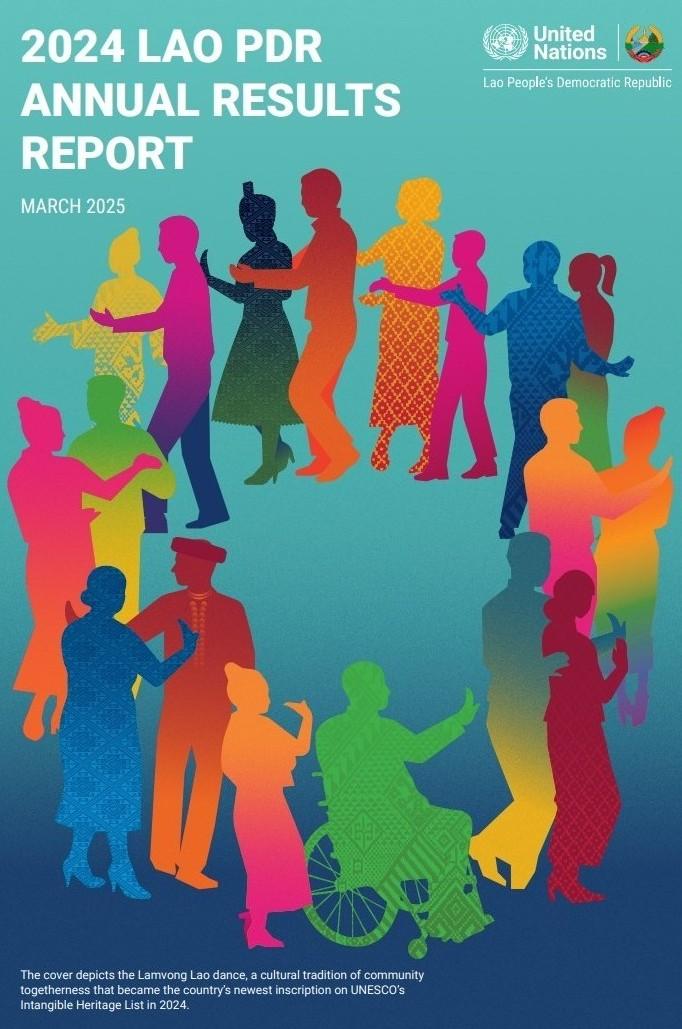
Publication
01 April 2024
2023 Common Country Analysis Update
The Common Country Analysis (CCA) is a reflection of evolving country contexts that identifies key development challenges. The CCA is an essential tool used by the UN country team (UNCT) to ensure appropriate and focused programming that tackles the right issues in the right ways. The UNCT is implementing the Lao PDR-UN Sustainable Development Cooperation Framework 2022-2026 (UNSDCF) to improve the efficiency and effectiveness of its programming, and the regular update of the CCA is a crucial part of this effort.The UNSDCF, jointly designed by the Government of Lao PDR and 25 UN agencies, funds, and programmes, aligns with national development priorities and builds on the CCA's findings. To ensure that the UN programming remains relevant and up-to-date, the CCA is reviewed annually, and the first update was released in December 2022. The update reflects new developments and highlights emerging challenges that require changes to UN programming using a simple color-coding. The CCA update was prepared by the Programme Oversight Group and endorsed by the UNCT and the Lao PDR Government.
1 of 5
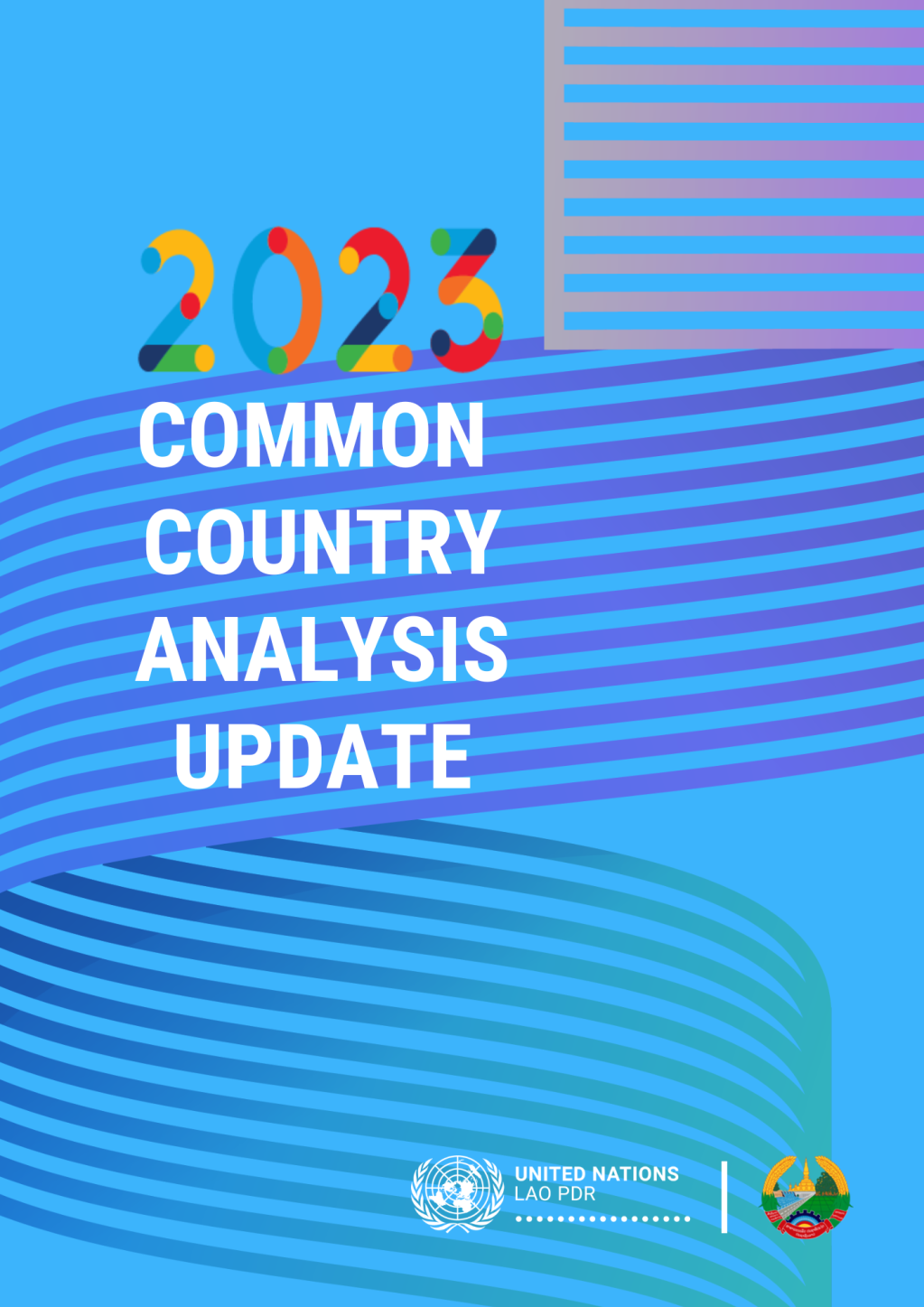
Publication
02 November 2022
Joint Programme on High-Frequency Data: Bulletin 1 Vulnerable Groups
This information bulletin was jointly developed by the Macroeconomic Research Institute, LASES, and the UN in Lao PDR under the Joint Programme on “High Frequency Data” in response to the current food, energy, and financing crises. The bulletin spotlights Vulnerable Groups in the context of the financial and socio-economic challenges in Lao PDR and is the first bulletin in a series as part the Joint Programme. The second one will provide information on “Food Security and Livelihoods” and the third bulletin is on “Macroeconomic analysis of the country’s economy”.
More about the programme:
The Joint Programme was set up in the context of the rapidly depreciating value of the KIP and the rising prices for food, fuel and fertilisers which came on top of the already exacerbated financial and socio-economic vulnerabilities. The current shocks can affect a wide range of individuals in many areas ranging from employment status, education, food consumption to gender-based violence. To capture these recent manifestations and potential trends, the Joint Programme considers collected data from households and businesses across the country as well as macro-economic developments.
Until December 2022, the data collected and related analysis will be made available to interested stakeholders and distributed through three information bulletins and discussed during a multi-stakeholder workshop towards the end of the programme. The outcome of this workshop as well as the most significant findings of the three bulletins will be summarised in a final policy report. This Joint Programme is funded by the Joint SDG Fund’s Development Emergency Modality, which was set to give more than 100 UN country teams worldwide the opportunity to receive fast and flexible seed financing to support governments in understanding the current changes and needs to tackle the ongoing global food, energy, and financing crises.
1 of 5

Publication
23 December 2022
Joint Programme on High-Frequency Data: Bulletin 2 - Food Security and Livelihoods
This information bulletin was jointly developed by the Macroeconomic Research Institute, LASES, and the UN in Lao PDR under the Joint Programme on “High Frequency Data” in response to the current food, energy, and financing crises. The bulletin spotlights Vulnerable Groups in the context of the financial and socio-economic challenges in Lao PDR and is the second bulletin in a series as part the Joint Programme. The second one provides information on “Food Security and Livelihoods” and the third bulletin will be on “Macroeconomic analysis of the country’s economy”.
More about the programme:
The Joint Programme was set up in the context of the rapidly depreciating value of the KIP and the rising prices for food, fuel and fertilisers which came on top of the already exacerbated financial and socio-economic vulnerabilities. The current shocks can affect a wide range of individuals in many areas ranging from employment status, education, food consumption to gender-based violence. To capture these recent manifestations and potential trends, the Joint Programme considers collected data from households and businesses across the country as well as macro-economic developments.
Until December 2022, the data collected and related analysis will be made available to interested stakeholders and distributed through three information bulletins and discussed during a multi-stakeholder workshop towards the end of the programme. The outcome of this workshop as well as the most significant findings of the three bulletins will be summarised in a final policy report. This Joint Programme is funded by the Joint SDG Fund’s Development Emergency Modality, which was set to give more than 100 UN country teams worldwide the opportunity to receive fast and flexible seed financing to support governments in understanding the current changes and needs to tackle the ongoing global food, energy, and financing crises.
1 of 5

Publication
08 May 2023
Joint Programme on High-Frequency Data: Bulletin 3 - Macroeconomic Outlook of Lao PDR
This information bulletin was jointly developed by the Macroeconomic Research Institute, LASES, and the UN in Lao PDR under the Joint Programme on “High Frequency Data” in response to the current food, energy, and financing crises. The bulletin spotlights Vulnerable Groups in the context of the financial and socio-economic challenges in Lao PDR and is the second bulletin in a series as part the Joint Programme. The second one provides information on “Food Security and Livelihoods” and the third bulletin will be on “Macroeconomic analysis of the country’s economy”.
More about the programme:
The Joint Programme was set up in the context of the rapidly depreciating value of the KIP and the rising prices for food, fuel and fertilisers which came on top of the already exacerbated financial and socio-economic vulnerabilities. The current shocks can affect a wide range of individuals in many areas ranging from employment status, education, food consumption to gender-based violence. To capture these recent manifestations and potential trends, the Joint Programme considers collected data from households and businesses across the country as well as macro-economic developments.
Until December 2022, the data collected and related analysis will be made available to interested stakeholders and distributed through three information bulletins and discussed during a multi-stakeholder workshop towards the end of the programme. The outcome of this workshop as well as the most significant findings of the three bulletins will be summarised in a final policy report. This Joint Programme is funded by the Joint SDG Fund’s Development Emergency Modality, which was set to give more than 100 UN country teams worldwide the opportunity to receive fast and flexible seed financing to support governments in understanding the current changes and needs to tackle the ongoing global food, energy, and financing crises.
1 of 5
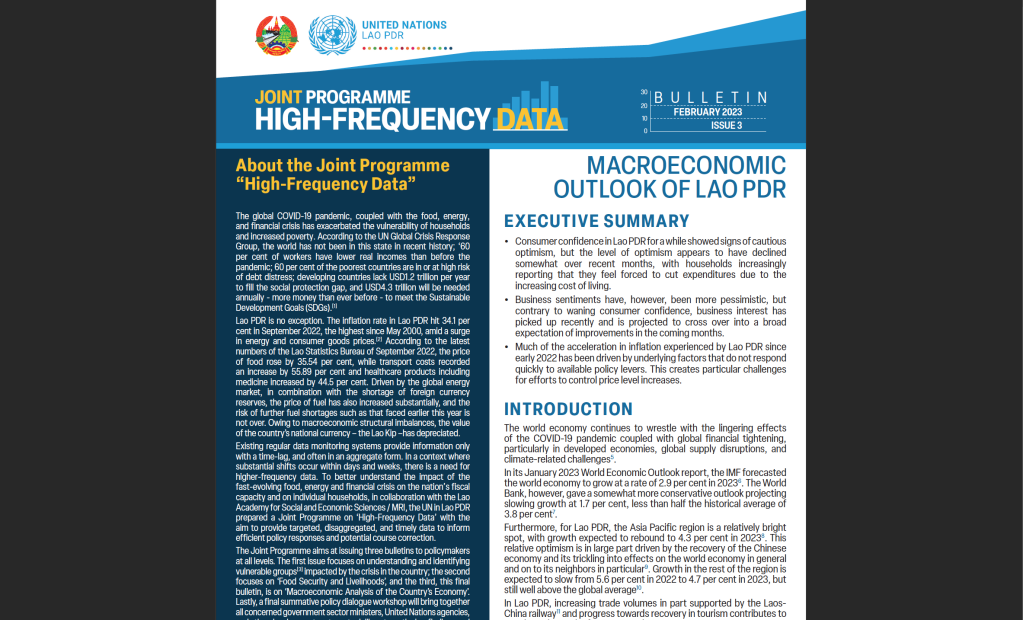
Story
17 December 2025
Brewing Change: From Opium Poppies to Premium Coffee in the Mountains of Lao PDR
(10 December, Xamneua, Lao PDR) – In the mist-covered highlands of Houaphanh Province, Vongsone carefully inspects his morning harvest among the red coffee cherries. A few years ago, this land grew a different crop — one that tethered communities to poverty and criminal networks. Today, these same hills are rewriting their story. This transition is at the heart of the Alternative Development Field Workshop, titled "From Theory to Practice," taking place this week in Xamneua District. Sponsored by the Government of China and organized by the United Nations Office on Drugs and Crime (UNODC) under the Mekong MOU framework, the event brings together government representatives from the Mekong and beyond, development partners, and practitioners to witness firsthand how long-term investment in licit livelihoods is reshaping the region. A Harvest of Hope Since 2015, UNODC, in close partnership with the Lao Government, has been working on the ground in Houaphanh, a region historically affected by opium poppy cultivation. The strategy was clear: replace the illicit drug economy with a sustainable value chain that empowers farmers "from seed to cup". The result is the Vanmai Coffee Cooperative. Established in 2020 to unite farmers and strengthen their collective bargaining power, Vanmai has become a beacon of success. Today, the programme supports 914 farming households in Houaphanh alone, helping them secure Fairtrade certification and connect with international buyers in Europe. “When I grew opium, I earned about 200,000 kip a year. Through the Alternative Development project, I began growing coffee and received support with farming, processing, and access to markets. Today, I earn much more - enough to send my children to school. Last year, I was even able to build a house in town for my family.” said Vongsone, coffee farmer, Ban Bone Village, Xamneua, Lao PDREmpowerment in Every Cup Beyond economics, the impact is deeply social. The Vanmai Women’s Network, established in 2021, has opened doors for women to take on leadership roles and engage in commercial activities. Income generated from coffee sales is being reinvested by communities into essential infrastructure, including schools, electricity, and sanitation. Farmers are also adopting climate-smart practices, such as shade-grown coffee and organic composting, ensuring that their development does not come at the cost of the environment.Looking Ahead As delegates gather in Xamneua to visit the coffee plantations and processing centres, the focus is also on the future. The successful model in Houaphanh is already being replicated in Phongsaly Province, where an additional 393 households are now receiving support, bringing the total beneficiary base to over 1,300 families.“Alternative Development is not about replacing one crop with another. It is about building a value chain that restores trust and opens long-term opportunity. What we have seen here is the progress made through sustained commitment, strong partnerships, and, above all, communities who have welcomed us into their homes. That trust carries responsibility, and it is not something we take lightly.” Said Thida Soukthavone, Officer-in-Charge, Alternative Development Programme, UNODC Lao PDR OfficeSupported by the Governments of Luxembourg, Italy, Germany, the United States, and Japan, this initiative proves that with the right support, communities can transition from vulnerability to resilience — one coffee bean at a time.The blog is written by Daiming Huang, Digital Media Officer, UNODC ROSEAP
1 of 5

Story
16 October 2025
OP-ED: Fund resilience, not disasters to secure Laos’ resilient future
this year’s global theme “Fund Resilience, Not Disasters” resonates deeply with the national context of Lao PDR. It is a message grounded in data, economics and human security; the costs of disasters are immensely underestimated, and the price of inaction is unsustainable.Lao PDR is at High RiskThe UNDRR’s 2025 Global Assessment Report estimates that the true cost of disasters is 11 times higher than the direct economic costs, standing at an estimated $2.3 trillion a year. For countries like Lao PDR, each disaster can cause cumulative and disproportionate damage, wiping out development gains, overwhelming public systems, increasing debt burden, and negatively impacting on MSMEs and a growing private sector. Without strategic investment, this cycle will worsen as international assistance declines and humanitarian needs rise.Lao PDR is among the countries most vulnerable to climate and disaster risks. The 2024 INFORM Index classified Lao PDR as having very high exposure to floods, with medium vulnerability and high lack of coping capacity. According to the Lao disaster database, between 2000 and 2024, a total of 4,483 disasters events, mostly floods, storms and landslides, affected over 4 million people and cost over USD 600 million in economic losses. In 2024 alone, monsoon floods and tropical storms impacted over 271,000 people, causing USD 313 million in direct damages. As of August 2025, an estimated 305,258 people, including 137,828 women, were affected, with damages exceeding USD 114 million.Moreover, Lao PDR’s temperature is rising at 0.05°C annually, potentially leading to a 3.6°C increase by the end of the century, with the southern part of the country heating even faster. In April 2023, Laos recorded its hottest day ever, nearing 44°C, putting agricultural productivity, energy output and public health increasingly at risk. It is projected that by 2050, 4 million people in Lao PDR will be exposed to extreme heat, compared to a baseline of zero exposure in the year 2000. A Strategic Shift Toward ResilienceTo reverse these trends, countries must accelerate the full implementation of the Sendai Framework in the remaining five years.Lao PDR is making deliberate shifts toward proactive risk governance. At the country level, the Disaster Management Law (2019) and the National Strategy for Disaster Risk Reduction (NSDRR) 2021–2030 provide the legislative and strategic backbone for a more resilient nation. Key institutions such as the Central Disaster Management Committee, led by the Deputy Prime Minister, and the National Disaster Management Office under the Ministry of Labour and Social Welfare, anchor coordination. Subnational Disaster Management Committees (DMCs), now operational in all provinces, as well as in some districts and villages, ensure that local needs and capacities are integrated into national planning. Strengthening Systems and GovernanceLao PDR has also made tangible progress in strengthening disaster and climate resilience. Early warning systems are being enhanced through improved hydrometeorological infrastructure, and broader community engagement. The National Early Warnings for All (EW4All) roadmap aims to improve inclusive, accessible and actionable early warning messages to all population, including the most vulnerable and remote communities across the country. Risk knowledge has expanded with the upgrading of the Lao Disaster Information system to track historical disaster events, the launch of impact-based forecasting pilots, and anticipatory action-based interventions. This risk knowledge plays a key part in developing and implementing national and sub national disaster risk reduction strategies and action plans.Under the Lao PDR - United Nations Cooperation Framework (2026-2031), UN agencies have come together to support the Government in strengthening policies, strategies and programmes to build resilience. The Inter-Agency Standing Committee mechanism supports government leadership on disaster preparedness and response. Together, these initiatives are making schools, health centers and food systems more climate-resilient and shock-responsive.But more remains to be done. Hydrometeorological coverage and early warning dissemination are uneven. A recent National Early Warning System Perception Survey found that 41% of the interviewed population, particularly those in remote and vulnerable communities, still lack access to early warning messages. And local disaster management committees often lack the technical and financial resources needed to act effectively.And fully implementing the Sendai Framework requires prioritizing financing for resilience and de-risking investment and financing.Finance and Innovation in Climate and Disaster Risk ReductionFor the 2025 International Day for Disaster Risk Reduction, we are calling on everyone to “Fund Resilience, Not Disasters”. This means two distinct actions: Increasing funding for disaster risk reduction and building resilience, especially within national budgets and international assistance,. and ensuring that public and private sector investments are guided by an understanding of climate and disaster risks. Making all development risk-informed will not only prevent the creation of new disaster risks, but will also help protect these investments from being lost to disasters.Recognizing the deep link between climate change and disaster risks, Lao PDR is aligning its financial systems to support resilience. The 2024 Carbon Decree marks a significant milestone, creating a regulatory framework for a domestic carbon market that will fund forest protection and low-emission development. The recently launched UN Joint Programme on Green and Climate Finance, led by the Ministry of Finance, is working to integrate disaster risk reduction objectives into public budgeting, and facilitating access to international climate finance. The Ministry of Finance is leading work to quantify disaster and climate risks to better manage fiscal exposure and prioritize investments in risk mitigation. This approach supports the implementation of the National DRR Action Plan and aligns with the Financing Strategy of the National Socio-Economic Development Plan (NSEDP). By integrating risk data into public financial management, Lao PDR can make more informed, cost-effective decisions that protect development gains.Despite these innovations, funding remains a constraint. Many disaster risk management plans, particularly at subnational levels, remain underfunded. The Way ForwardTo continue and further consolidate the shift from vulnerability to resilience, there are several strategic steps that Lao PDR can take.First, to fully operationalize the National Strategy for Disaster Risk Reduction 2021-2030, the Government could elaborate clear, costed targets and make dedicated budget allocations at all administrative levels. Second, accelerate the implementation of the National Early Warnings for All roadmap, ensuring that early warning systems reach all communities, especially those at greatest risk. Well-funded early warning systems are among the most cost-effective investments in disaster resilience, with high cost savings and returns in the rage of 1:20 cost-benefit ratio.Third, all development sectors including education, agriculture, health, infrastructure, natural resource management and social welfare, would significantly benefit from integrating disaster risk reduction and climate adaptation measures – so that public spending in every sector adds to resilience rather than amplifying risk. Fourth, risk-informed financing mechanisms could be expanded, including scaling-up budget tagging for disaster risk reduction, establishing contingency funds, and fostering public-private partnerships that leverage innovation and investment for resilience building.Lao PDR would also benefit from an integrated national risk platform, enabling better data-driven planning and decision-making. Reliable risk data ensures that funds are directed where they can have the greatest long-term impact.Finally, by institutionalizing mechanisms to address long-term climate loss and damage and by empowering local actorsto manage resources and implement community-based resilience measures, Lao PDR can ensure that every kip invested contributes to sustainable, locally-owned resilience.A Call to ActionResilience is a choice between short-term reaction or long-term protection. Between escalating costs or sustainable development. Between humanitarian crises or empowered, risk-informed communities.Risks can be turned into opportunities by investing in resilience. By funding resilience rather than disasters, Lao PDR can secure a safer, more sustainable future for all, and share its experiences in the region and beyond, to strengthen a wider cooperation in what truly is a vital field.OP-ED copenned By Mr. Bakhodir Burkhanov, UN Resident Coordinator in Lao PDR, and Marco Toscano-Rivalta, Chief, United Nations Office for Disaster Risk Reduction (UNDRR) Regional Office for Asia and the Pacific
1 of 5

Story
21 August 2025
Learning, Leading, Lifting: Toukkata’s Journey to Empower and Inspire
Growing up in a modest household in Savannakhet province, Toukkata’s world was shaped early on by her curious nature and a steadfast commitment to realize her dreams.Her family lived in a simple wooden home surrounded by tall trees—situated near a local guesthouse. As far back as she could remember, confused visitors—often foreigners—would wander up to their door, mistaking her home for the guesthouse. They would often ask for directions, speaking in languages she didn’t yet understand—an experience that stirred something in her. Young Toukkata became increasingly fascinated by these encounters, wondering who these visitors were, where they came from, and how she could communicate with them. Eager to understand and connect, she turned to her grandfather, a French speaker, asking, “How can I talk to them too?” That question marked the beginning of her journey into languages—and into the world.She began learning French from her grandfather and later enrolled in a bilingual programme at her local secondary school. Spanish came next, taught by a friend. English soon followed—after 10 months of extra classes and self-study, aided by a smartphone she had saved up for. “Buying a smartphone is expensive,” she said. “So, I told myself—why not use it to learn and create a better future?”Her passion for learning never waned, even as life presented its challenges. At 15, Toukkata took on her first job to support her family and became an adoptive mother to her infant niece. From kitchen work to guiding tourists etc, she never shied away from hard work and always striving to lift up those around her while inching closer to her goals.While studying French linguistics from high school through university, she also served as Head of Volunteers at the Savan Center—a youth space supported at the time by the Finnish government. The Center welcomed all young people—regardless of backgrounds, including all genders and persons with disabilities —it offered a platform to share, connect, and seek support. Toukkata became a familiar face, listening to others, offering advice, and quietly growing her own voice along the way.After graduation, she landed a job as an interpreter with The HALO Trust, an international demining organization that is working to find and remove bombs left over in Laos from the second Indochina War, and it was an opportunity that excited her deeply. “I loved the job,” she said. “But I wanted to do more to connect people, to coordinate, to help partners work better together.”It was her colleague, Sian Mullen—a British woman who recognized her potential—who introduced her to a unique opportunity: the UK Embassy Women’s Leadership Mentoring Programme 2025.Launched in early March 2025, the Programme paired young Lao women with female leaders from international organizations including the United Nations Development Programme (UNDP), the United Nations Resident Coordinator’s Office (UNRC), the United Nations Children’s Fund (UNICEF), the International Organization for Migration Organization (IOM), the Food and Agriculture Organization of the United Nations (FAO), and the Asian Development Bank (ADB). The call for applications had been shared on Facebook—a chance Toukkata had almost missed.Despite living near a noisy road, she recorded several takes of her video application on her phone until one was clear enough. Doubts crept in—was she good enough? But she remembered her colleague’s belief in her. She clicked submit.Weeks later, a message arrived: she had been selected. She traveled to Vientiane for the first time to attend the mentorship launch event at the British Embassy, where she met her mentor: Shairi Mathur, Head of Office at the UN Resident Coordinator’s Office. The two were paired because of their shared interests and Toukkata’s drive. Though they lived far apart, they met regularly online and scheduled informal check-ins.“My mentor has given me such invaluable support,” Toukkata shared. “I could text her any time I needed guidance or felt unsure. She helped me figure out what I truly wanted and how to go after it.”Together, they created a plan with clear, achievable goals. Toukkata wanted to grow in her career, become a liaison officer, improve her strategic thinking, and build confidence. Slowly but surely, progress followed. And recently, after silencing her own inner questions she applied for the position she had dreamed of.She got the job.Today, Toukkata is a Liaison Officer with The HALO Trust. Two of her three goals have already been met. The last one is a building confidence, and it is a journey she continues, with strength and intention.“Working with youth from so many different backgrounds has taught me that we all need someone to listen to us, to believe in us, and to help us grow,” she said. “I may not have all the answers, but I know now—the most important voice you must hear is your own. And the road becomes a little less daunting when you know you’re not walking it alone.”On June 24th, 2025, Toukkata stepped into the UN House for the very first time—a quiet but powerful milestone in her journey. Meeting her in person was more than just a moment; it was a vivid reminder that hope, perseverance, and the right support can turn even the smallest voices into powerful forces for change.Her story is not just about personal triumph, it’s about what becomes possible when someone dares to believe in themselves and is met with belief from others.
1 of 5
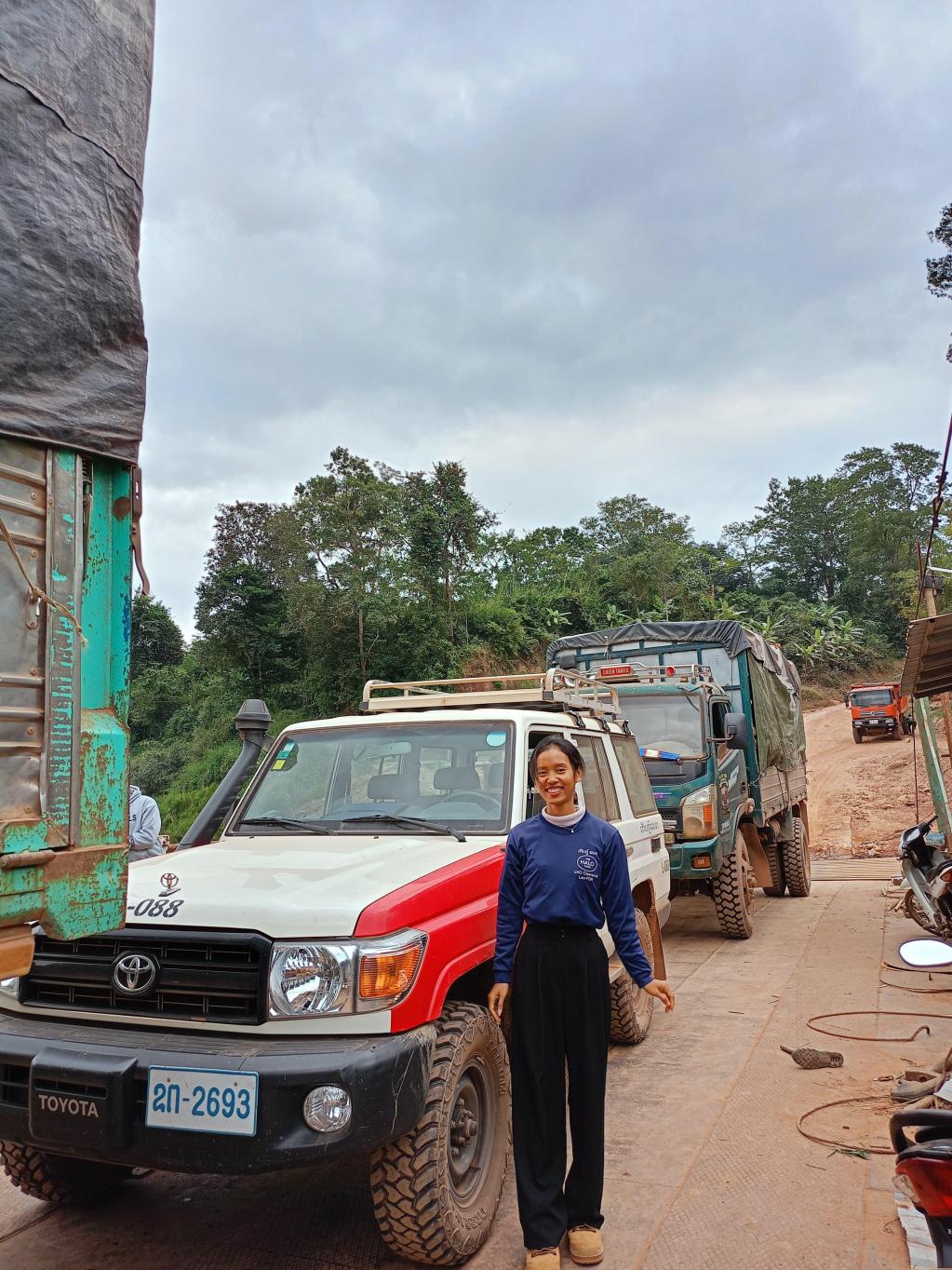
Story
19 August 2025
Natar-Yai Village Learns to Adapt with Floods
Big floods happened in 1997, 2011, 2019, 2021, and most recently in 2025, mostly due to tropical storms like Wipha. Each time, the community has learned more about how to prepare and respond better.This year, the villagers received an early warning on 21 July, two days before the flood came. The message was sent through mobile phones, loudspeakers and family heads to family members and neighbors as well. It was clear and easy to understand. The village head and local monitored the situation and quickly informed all households and asked them to get ready to evacuate.Families helped each other. Persons with disabilities and children were moved first to safe places. Some people stayed with relatives, while others went to the village temple, village office, and other household spaces, where are available in the village nearby. There is no official shelter in the village, so families relied on each other for support. The temple in the village was also flooded, the monks also relocated to nearby temple.A woman from the village said, “In 2021, the flood was worse. This time, early warning and good preparation helped us stay safe.” Still, the flood caused problems. One person was hurt. Many families lost important items like washing machines, kitchen tools, clothes, and cabinets. The flood came at night, which made it hard to manage the evacuation.The military and police came to help on time to evacuate people and important assets. They also assisted in cleaning houses and moving heavy items during the flooding period and after water level went down. On the second day, when the water level went down, the Prime Minister visited the village. His visit gave hope and confidence to the people. All affected villages received 10 million per villages for assisting emergency support, Nator-Yai village also got the same support. Families still need more help, especially rice, seedling, and household items to restart their lives. Some areas still need debris removal.In recent years, villagers received training on flood response from the government and development partners. But they say more is needed. They ask for better managed evacuation shelters, stronger riverbanks embankment protection, ongoing training to stay safe and potentially relocate to new location, where are safety and aways from flooded. With each flood, Nator-Yai becomes stronger and more prepared. Their story shows how local efforts, early warnings, and community support can save lives. As climate change brings more extreme weather, villages like Nator-Yai need more support to stay ready and resilient.The story is written by Sanjay Pariyar, Climate and Disaster Resilient Development Specialist, UN Resident Coordinator's Office/UNDRR, Lao PDR.
1 of 5

Story
29 July 2025
OP-ED: “A MOMENT OF OPPORTUNITY: SUPERCHARGING THE CLEAN ENERGY AGE”
Energy has shaped humanity’s path – from mastering fire, to harnessing steam, to splitting the atom. Today, we’re at the dawn of a new era. The sun is rising on a clean energy age.Last year, nearly all new power capacity came from renewables. Investment in clean energy soared to $2 trillion – $800 billion more than fossil fuels.Solar and wind are now the cheapest sources of power on Earth, and clean energy sectors are creating jobs, boosting growth and powering progress -- despite fossil fuels still receiving far greater subsidies.Countries that cling to fossil fuels are not protecting their economies, they are sabotaging them – undermining competitiveness, and missing the greatest economic opportunity of the 21st century.Clean energy also delivers energy sovereignty and security. Fossil fuel markets are at the mercy of price shocks, supply disruptions, and geopolitical turmoil, as we saw when Russia invaded Ukraine. But there are no price spikes for sunlight, no embargoes on wind, and almost every nation has enough renewable resources to be energy self-sufficient.Finally, clean energy spurs development. It can reach the hundreds of millions of people still living without electricity -- quickly, affordably and sustainably, particularly through off-grid and small-scale solar technologiesAll this makes the clean energy era unstoppable. But the transition is not yet fast or fair enough. Developing countries are being left behind. Fossil fuels still dominateenergy systems, and emissions are still rising when they must plummet to avoid the worst of the climate crisis. To fix this, we need action on six fronts.First, governments must fully commit to the clean energy future. In the coming months, every country has pledged to submit new national climate plans – known as Nationally Determined Contributions – with targets for the next decade. These plans must align with limiting global temperature rise to 1.5 degrees Celsius, cover all emissions and sectors, and lay out a clear path to clean energy. G20 countries, responsible for around 80% of global emissions, must lead.Second, we must build 21st century energy systems. Without modern grids and storage, renewable power can’t fulfill its potential. But for every dollar invested in renewable power, just 60 cents go to grids and storage. That ratio needs to be one- to-one.Third, governments must aim to meet the world’s surging energy demand with renewables. Major tech companies must also play their part. By 2030, data centres could consume as much electricity as Japan does today. Companies should commit to power them with renewables.Fourth, we must embed justice in the energy transition. This means supporting communities still dependent on fossil fuels to prepare for the clean energy future. And it means reforming critical minerals supply chains. Today, they’re riddled with rights abuses and environmental destruction, and developing countries are trapped at the bottom of value chains. This must end.Fifth, we must make trade a tool for energy transformation. Clean energy supply chains are highly concentrated and global trade is fragmenting. Countries committed to the new energy era must work to diversify supplies, cut tariffs on clean energy goods, and modernize investment treaties so they support the transition.Sixth and finally, we must drive finance to developing countries. Africa received just two percent of renewables investment last year, despite having 60% of the world’s best solar resources. We need international action – to prevent debt repayments sucking developing country budgets dry, and to enable multilateraldevelopment banks to substantially increase their lending capacity, and leverage far more private finance. We also need credit rating agencies and investors to modernise risk assessments, to account for the promise of clean energy, the cost of climate chaos, and the danger of stranded fossil fuel assets.A new energy era is within reach – an era where cheap, clean abundant energy powers a world rich in economic opportunity, where nations have the security of energy autonomy, and the gift of electricity is a gift for all.This is our moment of opportunity to supercharge the global shift. Let’s seize it.
1 of 5

Press Release
12 December 2025
Lao People’s Democratic Republic launches its first social security mobile application
Vientiane (ILO News) – The Lao Social Security Organisation (LSSO) has officially launched the Lao People’s Democratic Republic’s first social security mobile application, boosting accessibility to important services for rural and informal workers. The new LSSO app was developed with the support of the International Labour Organization (ILO)-China Partnership Programme and unveiled at the Second National Symposium on Social Protection held in Vientiane Capital on 12 December 2025. In its initial phase, the app can be used by informal workers to pay monthly contributions, check eligibility for various benefits, estimate benefit amounts and view information including contributions, payments and claims. The app will be upgraded over the next four years to expand its features and widen access to include those working in formal enterprises and public sector employees.Speaking at the launch, Chomyeang Pheangthongsawat, Director-General of LSSO said: “This mobile application is a bridge that leads us to the future. It will make social security services better, more convenient, and more accessible for everyone.”In the Lao People’s Democratic Republic social security services have only been accessible in person at LSSO branch offices and some bank branches. This makes it difficult for rural, informal and self-employed workers to pay contributions, verify eligibility, calculate benefits, or access treatment records. Manual, paper-based processes have in the past led to slow service delivery and inconsistent information, which ultimately affected user experience and perception.By making these services available on a single digital platform, the LSSO app directly addresses challenges related to travel, delays, lack of information and limited accessibility, particularly for rural and informal workers who previously relied on in-person visits. In parallel, ILO has been supporting LSSO to enhance interoperability of the social security database with other national systems. LSSO has developed Application Programming Interfaces (APIs) that connect LSSO with the population, business registration and medical information systems with the ultimate goal of improving law enforcement, increasing the membership base, and increasing revenues for the Fund.Xiaoyan Qian, Director of the ILO Country Office for the Lao People’s Democratic Republic hailed the launch of the app as a significant milestone. “This innovation brings social security services directly into the hands of workers. With a simple tap on their smartphones, members can do things that once required long waiting or travel times. This is more than a digital tool, it is a major step in modernising service delivery and strengthening trust in institutions.”Smartphone users will be able to download the app from Apple’s App Store and Google Play Store (for iOS and Android) from January 2026 onwards.The mobile app was developed, tested and launched with support from the “Extending social protection coverage to workers in the informal economy and leveraging digital transformation through South-South Cooperation” initiative under the ILO-China Partnership Programme.
1 of 5
Press Release
12 December 2025
Second National Symposium on Social Protection showcases digital transformations in Lao PDR
VIENTIANE (ILO News) – Digital innovation strategies that are strengthening public services and improving accessibility in the Lao People’s Democratic Republic took centre stage at the Second National Symposium on Social Protection, organized by the Ministry of Labour and Social Welfare (MOLSW) and the International Labour Organization (ILO) in Vientiane on 12 December 2025.As a national platform for dialogue, knowledge exchange, and collaboration among policymakers, practitioners, and international partners, the Symposium builds on last year's successful inaugural event and was centred on the theme “Digitalise, Transform, and Deliver in a New Era”. This initiative is supported by the ILO–UNDESA Project “Accelerating Universal Social Protection for Achieving the SDGs and Ending Poverty” with financial support from the United Nations Peace and Development Trust Fund.This year marks the end of the National Social Protection Strategy 2020–2025, with Lao People's Democratic Republic preparing for adoption of the 2026–2030 Strategy. Digitalisation will play a crucial role in shaping this new strategy, enabling better governance, smoother service delivery, and improved identification of vulnerable groups.Phosay Sayason, Minister of Labour and Social Welfare said during his opening remarks: “Social protection has gained real momentum in Lao PDR since the adoption of the first Strategy in 2020. Our vision is to build modern, connected systems that enable every Lao citizen to access their basic health and welfare needs easily and efficiently. As we advance into a new era, digital transformation is no longer optional – it is an essential tool for delivering public services.” In recent years, the Lao government has shown its commitment to modernising its social protection delivery systems. One of the key advances is the Social Registry, which allows more transparent and efficient identification of poor and vulnerable households and could evolve into a platform to harmonise delivery of various social protection benefits. Other major developments are the building of Application Programming Interfaces (APIs) to improve connectivity between public databases and enable easy, real-time data exchange. A highlight of the Symposium was the official launch of the first social security mobile application for Lao PDR.Xiaoyan Qian, Director of the ILO Country Office for Lao PDR added: “The LSSO app is a major milestone in modernising service delivery for informal workers and rural people who find it difficult to visit branch offices regularly. Digitalization opens new opportunities for graduation pathways—helping people move from social welfare into contributory schemes by simplifying registration, reducing administrative barriers, and improving enforcement and compliance. At ILO, we are proud to support these efforts.”Martine Thérer, acting United Nations Resident Coordinator in Lao PDR and UNDP Resident Representative added: “It is wonderful to see so many actors come together today and review the progress made in the last five years to build the foundations of a strong, comprehensive social protection system. Social protection is more than just a safety net, it is a foundation for resilience, equity, and sustainable development.”Prior to the high-level event on 12 December 2025, the Symposium held an event at the National University of Laos on 8 December 2025 to raise awareness among the youth and explore creative design ideas. Teams of students competed to present innovative social assistance delivery models in their communities, with the winners’ ideas showcased to policymakers.
1 of 5
Press Release
08 December 2025
Lao students lead innovation at National Symposium on Social Protection
Vientiane (ILO news) – Lao students have showcased their innovative ideas to strengthen social protection across the Lao People’s Democratic Republic at the 2nd National Symposium on Social Protection.The two-day event, held on 8 and 12 December 2025, provides a platform to showcase ideas, share knowledge and celebrate progress in strengthening the social protection system across the country. It brings together students, government representatives and development partners.Organized jointly by the Faculty of Social Sciences of the National University of Laos, International Labour Organization (ILO), and OXFAM, the highlight of the Symposium was a competition to strengthen youth engagement.Teams of third- and fourth-year students from the Faculty of Social Sciences presented their pioneering ideas on 8 December 2025 at the University Auditorium. Five finalist teams explored innovative solutions on the theme “How to better deliver social assistance services and monetary benefits to communities?”Speaking at the event, Associate Professor Dr. Somkhit Boilidam, Dean of the Faculty of Social Sciences stated, “By encouraging students to examine real-world challenges and propose practical, community-driven solutions from their perspective, the initiative nurtures the next generation of leaders in social development.”The five teams presented a diverse range of proposals, from improved payment mechanisms and digital accessibility features to community outreach models designed to streamline cash delivery. A panel of judges assessed the presentations based on innovation, relevance, feasibility and potential impact on vulnerable populations. The competition highlighted fresh perspectives and creativity that young people bring to advancing social protection in the country. At the event, students also experienced fun learning through games, quizzes and exercises, along with booth exhibits showcasing innovative projects and research, allowing attendees to engage and learn from practical demonstrations.The event served as a platform for student engagement, complementing high-level policy discussions on 12 December 2025, to discuss reform ideas and celebrate achievements in social protection from across the country."It is inspiring to see the creativity and commitment of these students in addressing real challenges faced by communities, while showcasing their understanding of how social assistance can be delivered more meaningfully," said Loveleen De, Social Protection Programme Manager at the ILO. "By bringing their perspectives to policymakers, their efforts are not only recognised at a national platform, but can also help to inspire innovative and tangible improvements in social assistance delivery," she added.This year also marks the 70th anniversary of the membership of the Lao People’s Democratic Republic in the United Nations. Lao youth have contributed to the celebration by designing a commemorative logo through creativity, passion and pride.
1 of 5
Press Release
19 November 2025
Government of Lao PDR Convenes 14th High-Level Round Table Meeting to Advance National Development Priorities and Launch Vientiane Declaration III
The HL-RTM, held once every five years, was officially opened by H.E. Mr. Sonexay Siphandone, Prime Minister of the Lao PDR, followed by a video message from H.E. Ms. Amina J. Mohammed, UN Deputy Secretary-General.“For Lao PDR’s smooth graduation from LDC status, we are preparing the country’s economic infrastructure foundation, building quality human resources, enhancing domestic production capacity and efficiency to increase regional and international competitiveness,” said the Prime Minister. Senior officials presented progress on the 9th National Socio-Economic Development Plan (NSEDP 2021–2025), priorities of the 10th NSEDP (2026–2030), and the country’s readiness for Least Developed Country (LDC) graduation in 2026.A landmark achievement of the 2025 HL-RTM was the launch and signing of the Vientiane Declaration III (2026–2035)—the next-generation framework that will guide development partnerships over the coming decade. Signed jointly by the Deputy Minister of Foreign Affairs of the Government of Lao PDR and the United Nations Resident Coordinator to Lao PDR, along with Development Partners, VD III renews commitments to country ownership, effective development cooperation, inclusive partnerships, and strengthened accountability. In line with this year’s theme, VD III places renewed emphasis on transitioning from an aid-driven model toward sustainable, diversified, and nationally-owned development financing, including domestic resource mobilization, innovation, resilience, climate action, and a smooth transition following LDC graduation.Throughout the Meeting, thematic presentations and plenary discussions highlighted Lao PDR’s progress and remaining challenges in macroeconomic stability, human capital development, governance, social services, green growth, and public financial management. Delegates underscored the importance of stronger data systems, enhanced domestic financing mechanisms, and more effective engagement of civil society and the private sector—key steps in reducing dependency on traditional aid modalities.In concluding, David McLachlan-Karr, Regional Director of the UN Development Coordination Office and co-chair of the HL-RTM, said: “Investments in human capital remain critical. With children and young people making up nearly half of the population, decisions taken today will shape development trajectories for decades to come. Strengthening small enterprises, advancing competitive industries, and rethinking skills development will be critical to expanding economic opportunities.” His remarks echoed the Meeting’s call to align development cooperation with Lao PDR’s long-term vision for self-reliance and sustainable financing.A Development Cooperation Exhibition, showcasing contributions from all Sector Working Groups, demonstrated innovations and field-level results across sectors. Senior leaders visited the exhibition and engaged with technical teams and development practitioners.The 14th HL-RTM concluded with a strong collective commitment to work toward sustainable, inclusive, and resilient development in Lao PDR. The Government expressed appreciation to all national and international partners for their continued cooperation and reiterated that the Vientiane Declaration III will serve as a cornerstone for a more coordinated, effective, and less aid-dependent development partnership in the decade ahead.On 20 November, a small number of heads of delegations will pay a courtesy call on the President of the Lao PDR to debrief on the HL-RTM proceedings and hear from the President on his strategic guidance for translating HL-RTM outcomes into action.For media inquiries:
Round Table Process Secretariat
Email: rtpsecretariat@gmail.com
Round Table Process Secretariat
Email: rtpsecretariat@gmail.com
1 of 5
Press Release
09 October 2025
High-Level Meeting of Sector Working Groups and Development Partners Ahead of 14th High-Level Round Table Meeting 2025
The meeting was co-chaired by H.E. Mr. Soulivath Souvannachoumkham, Deputy Minister of Finance, and Mr. Bakhodir Burkhanov, UN Resident Coordinator, and brought together chairs and co-chairs of SWGs, development partners, and UN colleagues.In his opening remarks, Deputy Minister Soulivath highlighted the importance of building a shared understanding among line ministries and development partners to ensure effective HL-RTM preparations.“Today’s meeting is an important opportunity for line ministries and development partners to exchange lessons, build common understanding, and ensure substantive preparation for the 14th High-Level Round Table Meeting. Efficient resource mobilization, public financial management reform, and coordination across Sector Working Groups are critical to successfully implementing the 10th National Socio-Economic Development Plan,” said the Deputy Minister.UN Resident Coordinator, Bakhodir Burkhanov emphasized the significance of the 10th National Socio-Economic Development Plan (NSEDP 2026–2030) for a resilient, self-reliant, and sustainable Lao PDR, highlighting the need to align the plan with the Smooth Transition Strategy as the country prepares to graduate from Least Developed Country status.“The 10th NSEDP is a crucial roadmap for a resilient, self-reliant and sustainable Lao PDR. As the country prepares to graduate from LDC status, we must ensure the plan is well-resourced, inclusive and forward-looking, including in how it promotes investments in jobs, youth, resilience and digital transformation,” said Mr. Burkhanov.He acknowledged the support of the Government of New Zealand for UNDP’s National Planning for Inclusive Development (NPFID) project and highlighted UN technical support through the inter-agency Learning, Evaluation & Data Group (LEAD) and the development of an M&E dashboard to strengthen results-based planning and transparency.The meeting included presentations on the fifth draft of the 10th NSEDP, the Monitoring and Evaluation Framework, and the Draft Financing Strategy, delivered by Mr. Sychantha Thammavong, Acting Director General of Planning, Ministry of Finance. Mr. Vongkhamheng Vongthachack, Director General of the International Finance and Cooperation Department, updated participants on HL-RTM preparations and requested SWG support for the pre-consultation meeting. Mr. Kouthong Sommala, Deputy Director, provided updates on the Vientiane Declaration III and Action Plan, emphasizing the need for efficient implementation mechanisms.The meeting concluded with a recap by Mr. Bakhodir Burkhanov, reiterating the importance of collaborative efforts in advancing Lao PDR’s development agenda. The 14th HL-RTM is expected to serve as a critical milestone in aligning national priorities with the Sustainable Development Goals and securing the necessary financing for their realization.For media inquiries, please contact:Aksonethip Somvorachit
Communications and Advocacy Officer, United Nations Resident Coordinator’s Office, Lao PDR
Email: aksonethip.somvorachit@un.org
Communications and Advocacy Officer, United Nations Resident Coordinator’s Office, Lao PDR
Email: aksonethip.somvorachit@un.org
1 of 5
Latest Resources
1 / 11
Resources
17 June 2025
1 / 11























